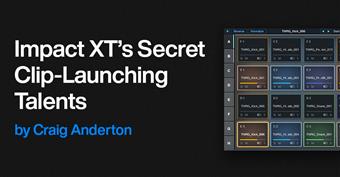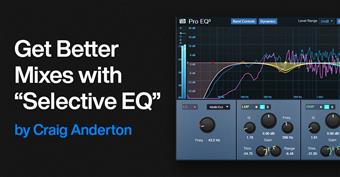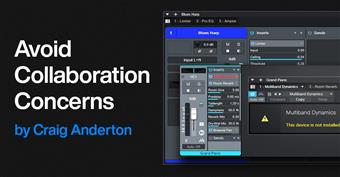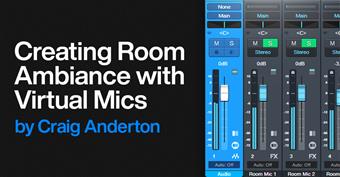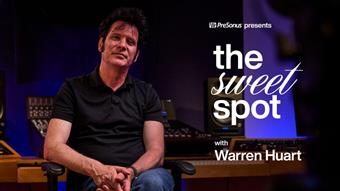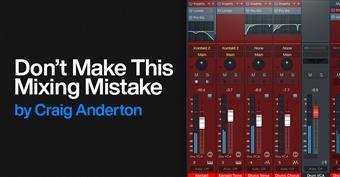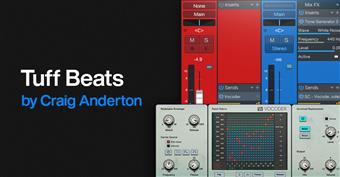
At first, the changes to the effects in Version 5 seem mostly cosmetic. But dig deeper, and you'll find there's more to the story-so let's find out what's new with Limiter2 (Fig. 1).
Figure 1: Limiter2 has had several design changes for Version 5.
The control parameters are more logical, and easier to adjust. Prior to V5, there was an unusual, by-design interaction with the Ceiling and Threshold controls; setting Ceiling below Threshold gave the limiter a softer knee. However, the tradeoff was difficulty in obtaining predictable results. Besides, if the soft knee aspect is important to you for dynamics control, just use the Compressor with a really high ratio.
In Limiter2, the Threshold is relative to the Ceiling-the Ceiling sets Limiter2's absolute maximum level, while Threshold sets where limiting begins below the Ceiling, based on the Threshold parameter value. For example, if Ceiling is 0.00 and Threshold is -6.00, then the limiter's threshold is 6.00 dB. But if the Ceiling is 3.00 dB and the Threshold is -6.00, then the limiter's Threshold is -9.00 dB. Makeup gain occurs automatically so that as you lower the Threshold parameter, the output level increases as needed to meet the Ceiling's target output level.
Modes and Attacks
There are now two Modes, A and B, and three Attack time settings. The pre-V5 Limiter had less flexible attack options, which mostly impacted how it responded to low-frequency audio; the waveform could have some visible distortion when first clamped, but the distortion would disappear after the attack time completed.
I'll spare you the hours I spent listening and nerding around with the (highly underrated) Tone Generator and Scope plug-ins to analyze how the new options affect the sound, so here's the bottom line.
In applications where you want to apply something like 6 dB of peak reduction to make a track or mix pop, the Limiter2 performance in Mode A is essentially perfect. Unless you're into extreme amounts of limiting or material with lots of low frequencies, Mode A should cover what you need 95% of the time (and it also outperforms the pre-V5 limiter).
If you're using Limiter2 as a brickwall limiter to keep transients from spilling over into subsequent stages, then use Mode A/Fast attack for the highest fidelity and give up a tiny bit of headroom, or Mode B/Fast Attack for absolute clamping.
Fig. 2 shows how the fast and slow times compare. The following were all set for 50 ms release times, 1 kHz sine wave input, and -20 dB Threshold-so Limiter2 was being hit pretty hard.
Figure 2: Fast and Slow attacks compared for Modes A and B, cropped to 150 ms duration. Top to bottom: Mode A/Fast, Mode A/Slow, Mode B/Fast, Mode B/Slow.
The visuals are helpful, but on signals with fast transients, you may hear more of a difference with the different attack times than these images might indicate. Nonetheless, it's clear that Mode B/Fast is super-fast. If you look carefully at Mode A/Slow, you'll see a very tiny downward blip on the first cycle of the attack (it's less visible on Mode B/Slow). Mode A takes about 20 ms to settle down to its final level.
Low-Frequency Performance
For more background on the nuts and bolts of how this works, the tradeoff for Mode B's higher speed mostly involves very low frequencies (under 80 Hz or so, and especially under 50 Hz). With a 50 Hz sawtooth wave, 100 ms Release, and a significant amount of limiting, Mode B/Slow gives some visible overshoot and distortion. Mode B/Fast reduces the overshoot but increases distortion. Mode A does less of both-with Slow, there's less overshoot, and with Fast, there's less distortion. Note that any distortion or overshoot occurs only when pushing Limiter2 to extremes: very low-frequency waveforms, with steep rise/fall times, short release times, and lots of limiting. However, this is mostly of academic interest with waveforms that have lots of harmonics, like sawtooth and square. The level of the harmonics is high enough to mask any low-level harmonics generated by distortion.
I also tested with a sine wave, which gives an indication of what to expect with audio like a kick drum (e.g., 40-60 Hz fundamental) or low bass notes. Mode B/Fast has less distortion than Mode B/Slow, while Mode A, fast or slow, flattens peaks almost indiscernibly (Fig. 3).
Figure 3: A 30 Hz sine wave with about 15 dB of limiting. Top: A Mode. Middle: B Mode/Fast. Bottom: B Mode/Slow.
In this situation, Mode A would likely be my choice, but as always, use your ears-the light distortion from Mode B can actually enhance kick drum and bass tracks. Also note that which mode to use depends on the release time. For example, with a short (35 ms) release, B/Slow had the most audible distortion, B/Fast was next, and B/Normal had no audible distortion.
While I was in testing mode, I decided to check out some third-party limiters (Fig. 4) with a different program. These are all marketed as vintage emulations, and set to the fastest possible attack time.
Figure 4: The results of testing some other limiters.
In case you wondered why some people say these vintage limiters have punch now you know why! The time required to settle down to the final level is pretty short (except for the bottom one), but the limiter doesn't catch the initial peaks. This is why you can insert one of these kinds of limiters, think you're limiting the signal, but the downstream overload indicators still light on transients. Incidentally, the Fat Channel's Tube limiter has this kind of vintage punch response in the Limit mode, while the Fat Channel's one-knob, final limiter stage-although basic-is highly effective at trapping transients.
More from PreSonus
19/04/2024
By Craig Anderton
Impact XT can launch clips, which is great for songwriting (see the blog post Songwriting with Impact XT). But few people realize that Impact...
12/04/2024
By Craig Anderton
Good mixes often depend on carving out a unique sonic space for each instrument, so you can hear them clearly. Sometimes carving out that spa...
05/04/2024
By Craig Anderton
MIDI guitars are a niche product, because the learning curve can be daunting for some guitar players. However, I'm surprised how many pro...
29/03/2024
By Craig Anderton
As the universe of Studio One users grows, so do opportunities for collaboration. But your collaborator may not be using the same version of ...
22/03/2024
By Craig Anderton
Over three years ago, I wrote a blog post on how to make a drumcoder. Its design was somewhat like a vocoder-drum audio served as a modulat...
15/03/2024
By Craig Anderton
One of Atmos's coolest features is scalability. No matter how complex your Atmos project may be, you can render it as Binaural, 5.1, 5.1....
13/03/2024
Watch the Brooklyn Synthpop duo remix their song Blame in Studio One
Less than 24 hours after meeting each other, producer Luke Moellman and vocalist Jon San...
10/03/2024
By Craig Anderton
The impetus behind this design was wanting to add envelope flanging to amp sims like Ampire. But there's a problem: most amp sim outputs ...
01/03/2024
By Craig Anderton
Supplementing close-miking techniques with room mics gives acoustic sounds a life-like sense of space. Typically, this technique involves pla...
27/02/2024
Notion Mobile v3 took mobile music creation to the next level with support for iOS, Android, Windows, Fire OS and macOS. Now v3.3 adds many enhancements and fix...
26/02/2024
Logic's Grammy-nominated producer breaks down his Sweet Spot.
Before he found success as an avant-garde hip hop producer, 6ix was just 30 units shy of a de...
25/02/2024
The Grammy-nominated multi-Platinum producer breaks down his Sweet Spot.
From the studio with chart-topping artists like Aerosmith and The Fray, to empowering ...
23/02/2024
By Craig Anderton
Do you think of mixes in absolute terms, or relative terms? Knowing the difference, and when to apply which approach, can make a huge differe...
16/02/2024
By Craig Anderton
Calling all beats/hip-hop/EDM/hard rock fans: This novel effects starts with drums modulating the Vocoder's white noise carrier, and take...
09/02/2024
This tip is about working with stereo, NOT about Dolby Atmos or surround-but we're going to steal some of what Atmos does to reinvent stereo panning. Stud...
07/02/2024
The GRAMMY-winning recording and mix engineer shows us how he uses Studio One to create an artful immersive mix.
Jeff Ellis is a force to be reckoned with. The...
02/02/2024
Presence's sound library includes a fine acoustic 12-string guitar, but not an electric one. So, perhaps it's not surprising that one of the more popula...
26/01/2024
At first, this might not seem too exciting. But follow the directions below, and try comping using this method-I don't think you'll be disappointed. Thi...
19/01/2024
You know the feeling: You're tracking or doing an overdub with a virtual instrument or amp sim, but you're frustrated by the excessive latency inherent ...
12/01/2024
Recording audio using more than one feed from the same source may create phase issues. For example, when miking a bass amp and taking a DI (dry) input, the DI&#...
05/01/2024
If you haven't experimented yet with mid-side stereo miking, you'll be in for a treat when you do. Here's why:
Record background singers with gorge...
29/12/2023
This complements the tip Better Ducking for Voiceovers and Podcasts and the tip Why I Don't Use Compression Anymore. It applies the concept of voiceover duc...
22/12/2023
Engineers sometimes advocate using high-pass filters to clean up the low end and tighten the sound. Others believe that because of issues inherent in highpass...
20/12/2023
The GRAMMY-nominated artist, producer, and songwriter shows us how he uses Studio One to cook a musical idea from scratch.
Josh Cumbee is a triple threat: The ...
15/12/2023
This wasn't a conscious decision, or something I planned. But when I looked through my last few songs while seeking candidates for a book's screenshots,...
08/12/2023
First, a follow-up: In the October 13 tip about creating Track Presets for parallel processing, I mentioned that Track Presets can't include buses, which is...
01/12/2023
Vocoder's aren't normal effects. For example, Arturia's Vocoder V is an effect/instrument hybrid, because it's an audio effect that includes a...
24/11/2023
For over a decade, stereo and mono vinyl records co-existed before the transition to stereo was complete. During that time, many records were released in both m...
17/11/2023
Strings can enhance almost any genre of music-and with a little more effort, you can do string arrangements that go beyond simply adding a string pad preset. So...
10/11/2023
Since Dynamic EQ was introduced in version 5, I've used it to replace and improve some techniques I used to do with static EQ. For example, I'm a fan of...
03/11/2023
Gregor Beyerle recently posted a video called Producer vs. Engineer-What's the Difference?, which had quite a few comments. It seems most people feel that f...
27/10/2023
Sending too many low frequencies through reverb gives a bloated, muddy sound. This is one reason why you'll rarely see a send from a bass track going into r...
20/10/2023
While trying to do something else with Melodyne, I stumbled on this way to add depth or tightness to drum sounds-quickly and easily. Here's the sound of an ...
13/10/2023
Parallel processing splits a signal into two or more parallel channels. Bi-amping is a common example of parallel processing:
One channel processes low frequen...
06/10/2023
Everyone talks about the importance of Dolby Atmos for post-production, but the implications go further than that. Atmos really does change how you create and ...
29/09/2023
You don't need a massive surround system with speakers wired all over your studio to create immersive audio. Whether you want surround or Dolby Atmos mixes...
22/09/2023
By Craig Anderton
Background music or environmental sounds are usually an essential part of commercials, movies, presentations, podcasts, and more. When doing ...
15/09/2023
The post Mixing la Studio One had a great response, so here's another tip that relates more to making better music than making better-sounding music. We&#...
08/09/2023
This FX Chain's inspiration is the Tilt filter circuit created by Tonelux designer Paul Wolff. First used in the Tonelux MP1A mic preamp, the Tilt filter h...
01/09/2023
But first, some breaking news: Version 1.5 of The Huge Book of Studio One Tips and Tricks is now available from the PreSonus shop. Like previous versions, it�...
25/08/2023
Studio One 6.2 reworked Layer and Take handling, and some of the new functionality is exceptionally useful. For example, suppose you want to record comp vocals ...
18/08/2023
We haven't done a boutique digital effect for Studio One Professional in a while, so let's use a plugin in a totally wrong way-yet end up with somethi...
11/08/2023
MIDI drum loops have a bad rap, because some musicians consider them metronomic and boring. But they don't have to be. Subtly leading or lagging the beat at...
04/08/2023
Ask 100 recording engineers about their approach to mixing, and you'll hear 100 different answers. Here's mine, and how this approach relates to Studio ...
28/07/2023
FL Studio is a cool program. Yet when some users see me working with Studio One's features like comping tools, harmonic editing, the lyrics track, Mix FX, M...
21/07/2023
Bass has a tough gig. Speakers have a hard time reproducing such low frequencies. Also, the ear is less sensitive to low (and high) frequencies compared to midr...
18/07/2023
Notion Mobile v3 took mobile music creation to the next level with support for iOS, Android, Windows and macOS. Now v3.2 adds many enhancements and fixes, as we...
14/07/2023
First, an announcement: If you own the eBook How to Record and Mix Great Vocals in Studio One, you can download the 2.1 update for free from your PreSonus acc...
07/07/2023
Let's transform your acoustic piano instrument sounds-with effects that showcase the power of Multiband Dynamics. Choose from two download links at the end ...
24/06/2023
Acoustic drum loops freeze-dry a drummer's playing-so, what you hear is what you get. What you get. What you get. What you get. What you get. What you get.
...
 At first, the changes to the effects in Version 5 seem mostly cosmetic. But dig deeper, and you'll find there's more to the story-so let's find out what's new with Limiter2 (Fig. 1).
At first, the changes to the effects in Version 5 seem mostly cosmetic. But dig deeper, and you'll find there's more to the story-so let's find out what's new with Limiter2 (Fig. 1).













